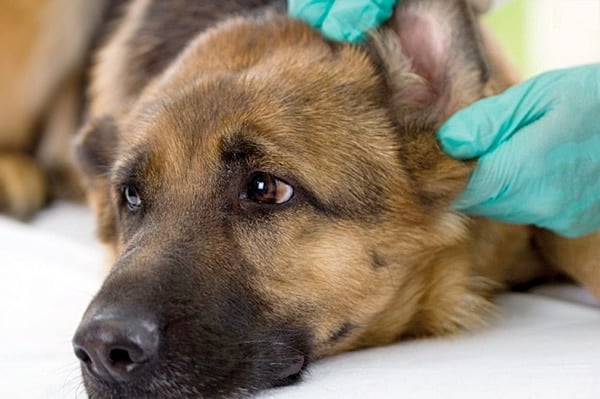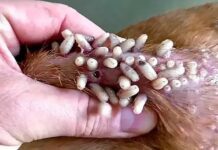At some point, you’ve most likely heard of this strange formation that some of our furry friends suffer from in their ears due to the rupture of a blood vessel within the membrane of the pinna (outer ear). Although it’s rare, more and more cases are happening lately, so it never hurts to know the reasons for its origin so you can help prevent them.
Let’s look at the main reasons that cause this inflammation, and the existing solutions and treatments to make sure that our beloved dog is completely healed.

What is an aural hematoma?
It’s simply a hematoma in your dog’s ear. As you know, hematomas (blood blisters) are produced by the accumulation of blood under the skin, resulting in those small or large dark circles, verging on purple, on our body or that of our dog.
The ears are composed of cartilage and skin with some blood vessels. If a blood vessel inside your dog’s ear is broken, chances are that blood will start to accumulate between his cartilage and skin, producing a hematoma, which when located in the ear is known as an aural hematoma or otohematoma.
The main problem with this is that in the ear there aren’t many blood vessels, so blood absorption can be complicated, causing it to not be absorbed and instead get stored in a pocket, giving your dog a swollen ear, like with a lump inside it. Obviously inside the lump there is only blood or blood serum, which should be aspirated at a veterinary clinic to avoid infection whenever the ear hematoma is of considerable size. The smallest ones can be treated simply with antibiotics to prevent any associated infections.
How do ear hematomas happen in dogs?
Usually they are caused by the dog’s excessive scratching. If your best friend has an ear infection, an allergy or parasite, he will suffer from severe itching that will make him scratch harder than usual. This can cause the rupture of a blood vessel leading to an aural hematoma.
A collision to the ear with another dog, a tree or anything else can also cause this problem.

What should I do if I find an aural hematoma on my dog?
Due to the strong inflammation that can occur, it is advisable to go immediately to your veterinarian to assess the problem and act accordingly. Never, under any circumstances, try to solve the problem on your own, because it can lead to serious infections that can disfigure your dog’s ear or even kill him.
If the otohematoma is small, your vet can empty it with the help of a syringe and prescribe a strong dose of some corticosteroids for the dog (anti-inflammatory) to ensure that the aural hematoma disappears by itself. Sometimes you have to go back several times to empty the hematoma, because if it swells a lot it expands.
If the ear hematoma is medium to large, possibly the best solution is for the vet to drain it and give us the appropriate treatment to avoid having to operate as much as possible… but usually, when it comes to large otohematomas, surgery is necessary.
Using an Elizabethan collar (cone) so your dog doesn’t scratch while you’re not watching is an excellent choice.
How do you cure an ear hematoma in dogs?
Sometimes having your vet drain the contents of the otohematoma is enough; sometimes it’s also necessary to inject some steroids after draining it or to prescribe oral corticosteroids. But usually, the solution to this problem is surgery.
The procedure involves completely sedating the dog, opening and emptying the aural hematoma and draining its entire contents, thoroughly cleaning inside and closing the wound with stitches. Because the skin does not naturally stick well to cartilage and the chances that the aural hematoma will reappear in the same place are high, the vet will proceed to make what you might call a small quilt.
Don’t be alarmed, it looks shocking but it’s really very simple, and it isn’t serious or dangerous. It consists of putting several stitches in the ear so that the skin is completely attached to the cartilage and will heal well and stay stuck to it. The vet may use direct stitches or may use a surgical pillow which will also absorb possible secretions.
The stitches must be left in for 10 to 15 days before removal, so putting on a cone to prevent your dog from scratching the wound is completely mandatory.



What treatment should be used after aural hematoma surgery?
Your dog must take all medications as assigned by the veterinarian who performed the operation. Usually, they consist of an antibiotic to prevent infection and an anti-inflammatory or corticosteroid, which will keep the recently operated ear from getting very inflamed and itching too much. Your vet will give you guidelines to follow, although it normally consists of administering medications correctly and cleaning the stitches a few times a day with a disinfectant or hydrogen peroxide diluted with water to 50%.
It is absolutely mandatory that your dog wears his cone at all times; this way, you’ll ensure that he doesn’t touch the wound and that it heals within the timeframe indicated.
…And then what?
Nothing – after the healing period, the veterinarian will remove the stitches and see if the operation has had the expected results. Normally, everything is healed and your dog is going home happy, but sometimes the wound has not healed well or the skin has not attached to the cartilage well enough and you’ll have to repeat the process.
If you follow the vet’s guidelines well and try to make sure your dog rests, it will usually be cured.
If you liked this article and found it useful, help us keep the site going! “Like” or share it on social media: Thank you! 🙂





